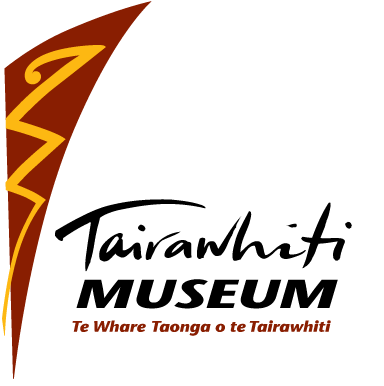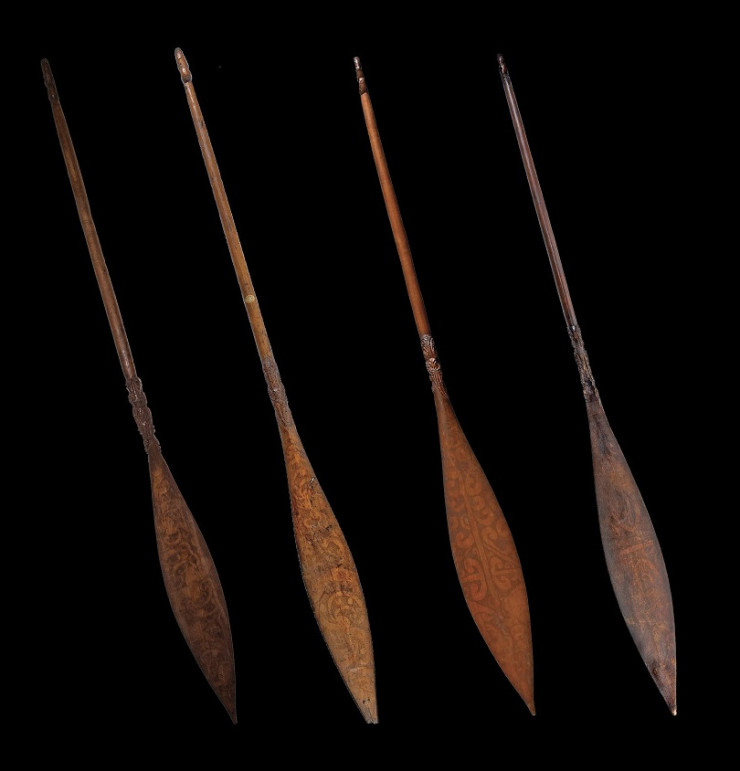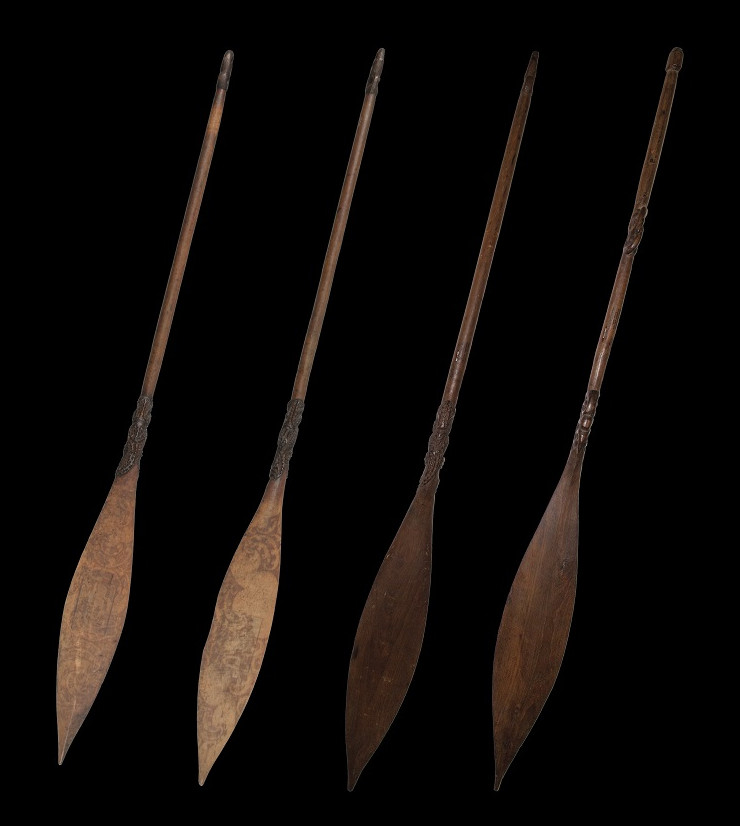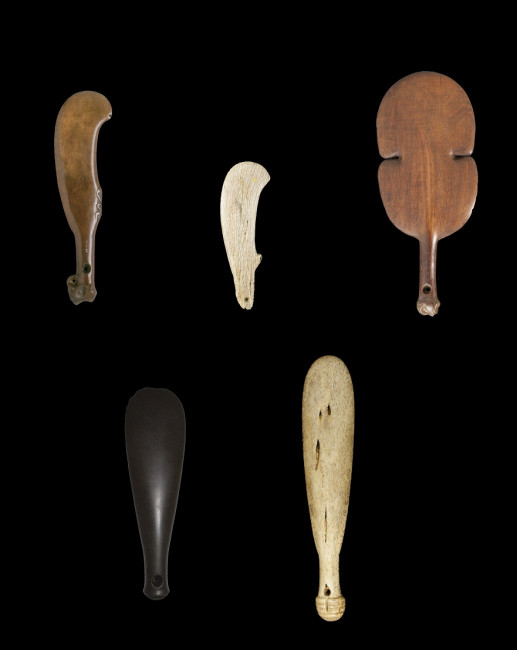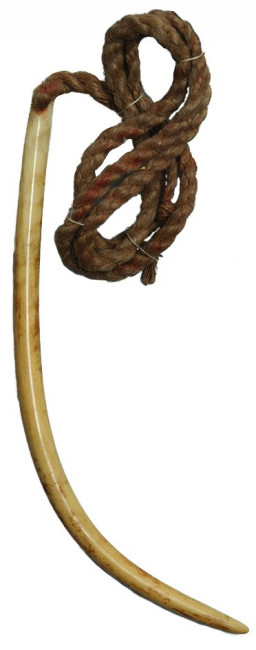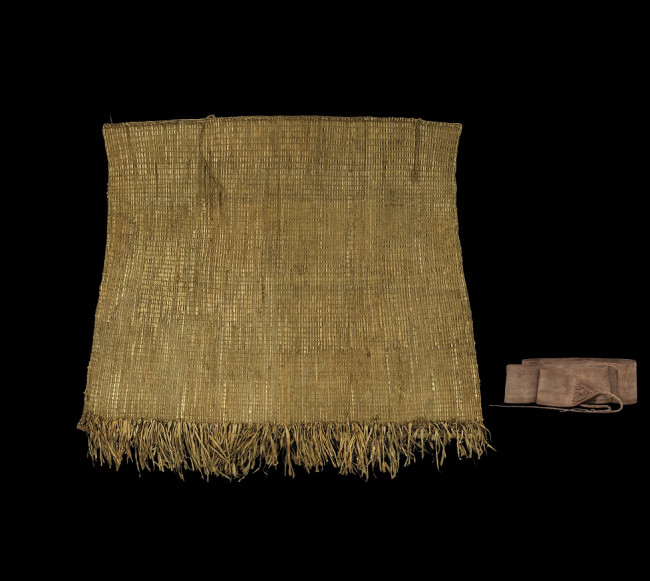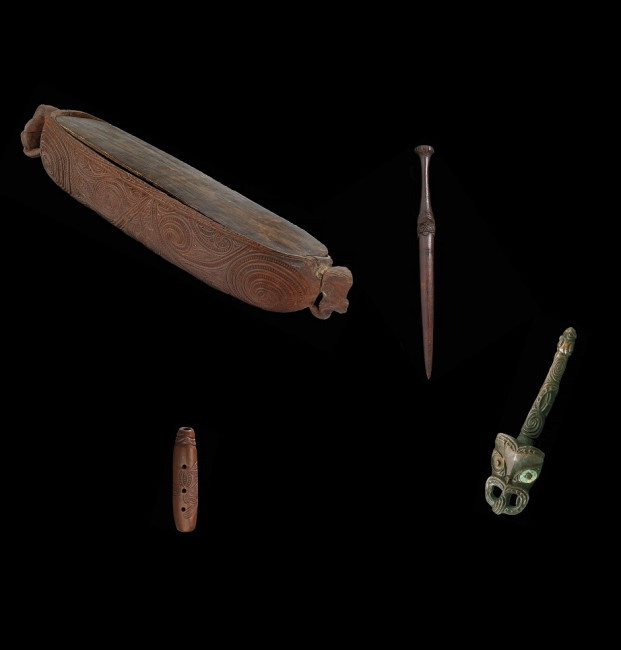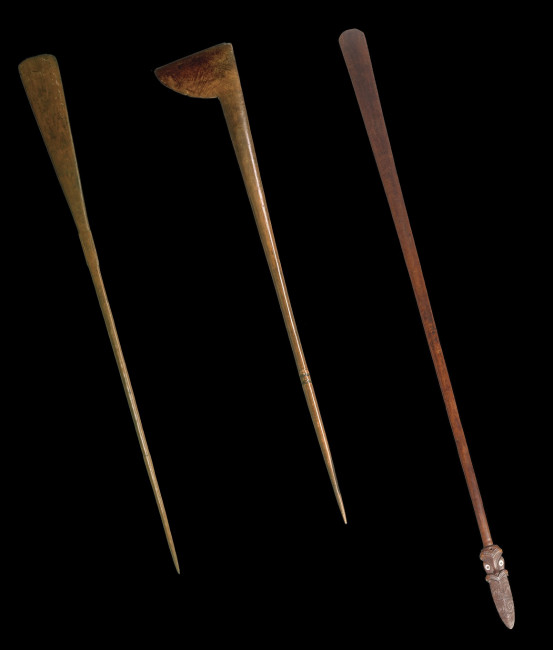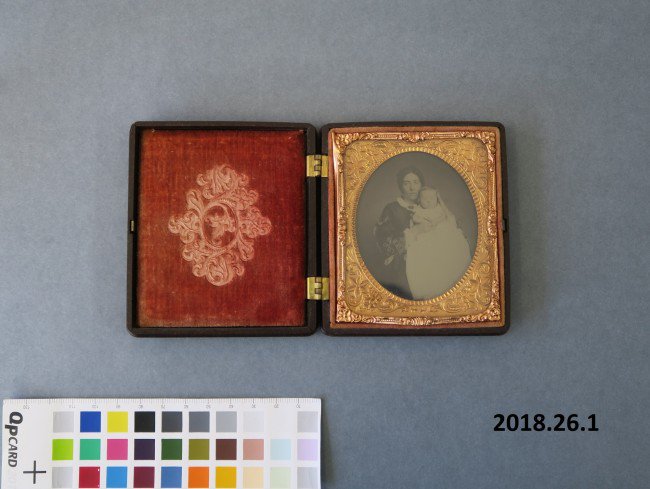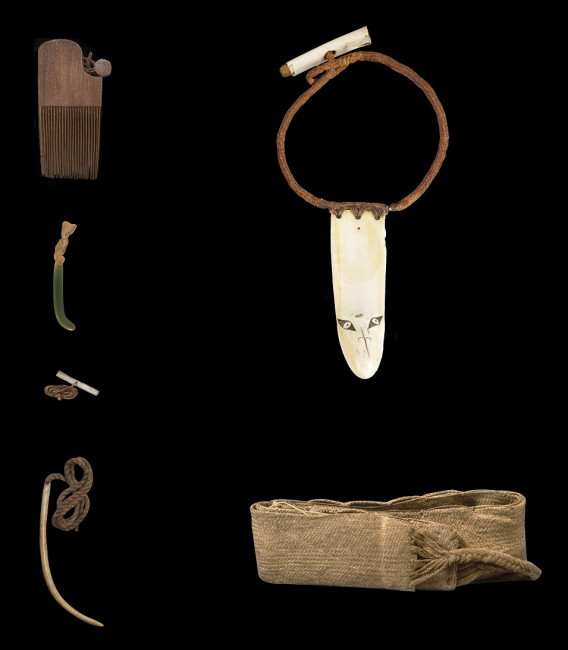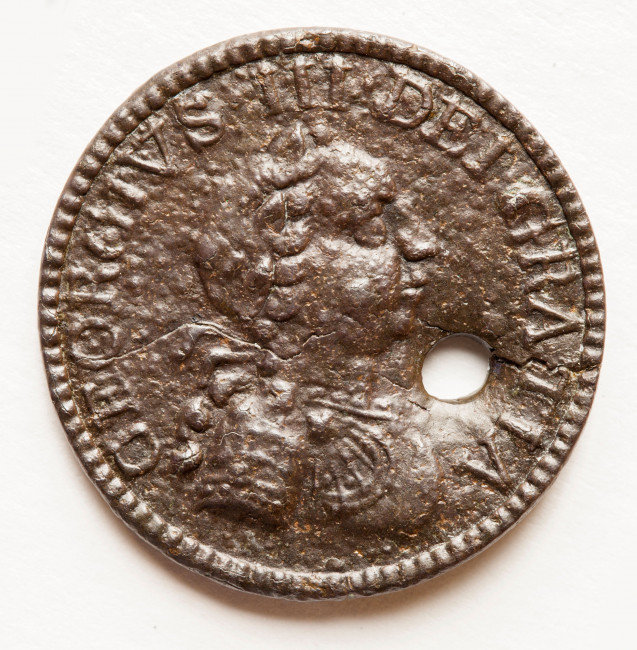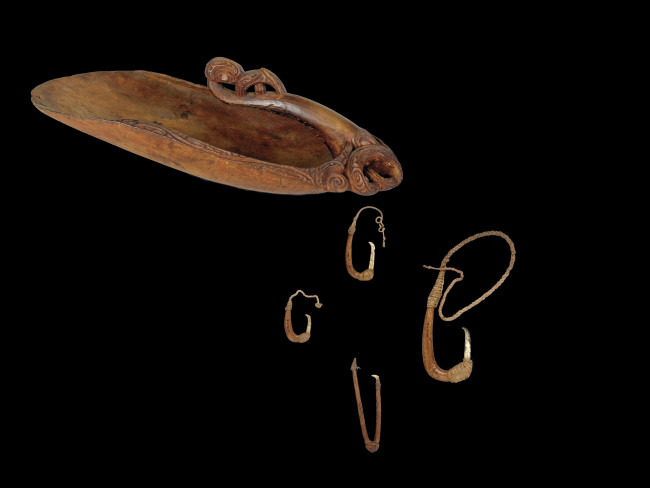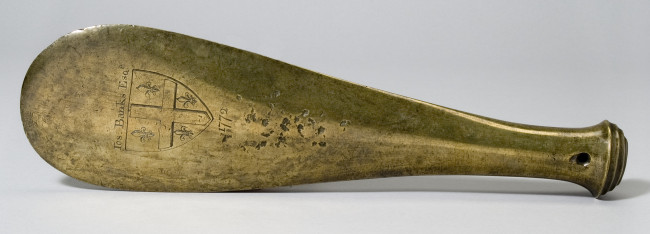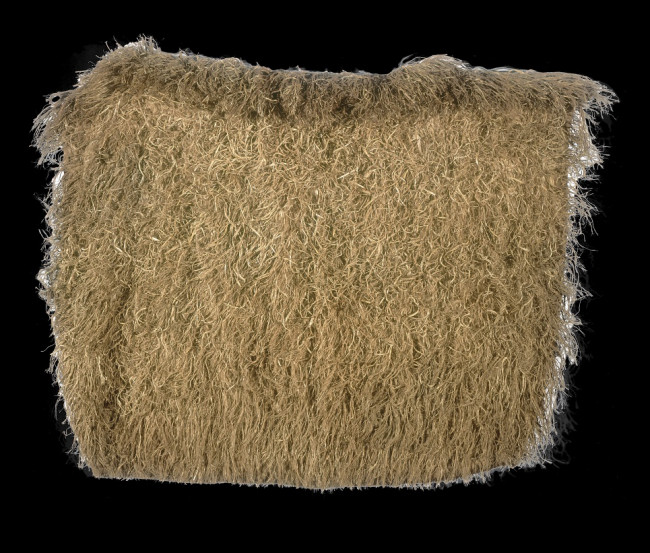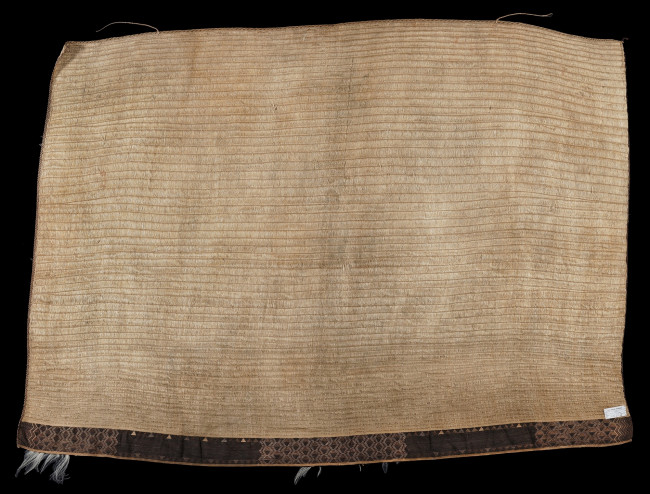Tīmata i te taha mauī
Hoe paddle
Rākau, kano māori
Wood, natural pigment
Ko te kōwhaiwhai, he mea kite i ēnei rā ki runga i ngā heke o roto i ngā wharenui. Nō waenga i ngā rau tau tekau mā iwa neke atu, i rongonui haere ai tēnei āhuatanga. Heoi anō, i kitea tōmuatia te kōwhaiwhai ki runga i te mata o ngā hoe. He nui tonu ngā hoe he mea whakairo ngā kakau, he kōwhaiwhai kei runga i ngā mata i kohikohia e Kuki i tana whakaterenga tuatahi I te tau 1769. He mea waituhi anō ngā hoe e Sydney Parkinson.
The flowing abstract pattern called kōwhaiwhai have become most commonly associated with those painted on the heke (rafters) of wharenui (meeting houses). These appeared from the mid-nineteenth century onwards. However, kōwhaiwhai were seen much earlier on portable taonga such as this painted hoe (paddle). Several paddles with carved handles and kōwhaiwhai designs on the blade were collected during Cook’s first voyage in 1769 and were also recorded in a water colour painting by Sydney Parkinson.
Case 5 hoe: On loan from Great North Museum Hancock, C589 and the British Museum, Oc1896.1147, Oc, NZ 150, Oc.5370
Hoe paddle
Rākau, kano māori
Wood, natural pigment
Ko te manaia kua whakairohia ki te whiti me te pito o te kakau, me tōna mata e whakataurite ana i ēnei hoe. Ko ōna tauira e tohu mai ana nā tētahi hunga kotahi i waihanga. Ko te nuinga he mahinga kōwhaiwhai kei ngā mata, ā, he rerekētanga anō tō ia. Ko ngā tohu kōwhaiwhai, he pītau, he kape, he mea i kitea tōmuatia i ngā mahinga kōwhaiwhai e kitea ana i ngā heke kei roto i ngā wharenui i waenga i ngā tau 1800. Ko te kano māori, tērā pea he kōkōwai, he mea ranu ki te hinu mangō.
The intricately carved manaia design around the ‘whiti’ (hand grip) and the carved manaia design at the top of the handle, along with the overall leaf shape of the blade give this unique set of hoe waka a commonality. The design elements make them part of a set that were probably crafted by the same people. Most of these hoe waka also have intricately painted designs on both surfaces of the blades. While each painted pattern looks similar they are in fact very different and represent the earliest form of what we now know as kōwhaiwhai. The painted patterns consist of ‘pītau’ and ‘kape’ design elements which pre-date the kōwhaiwhai painting that appeared on buildings during the mid 1800’s. The paintings on each blade incorporate elements of asymmetry and symmetry. The pigment was probably kōkōwai (red ochre) mixed with shark oil.
Case 7 hoe: On loan from Cambridge Museum of Archaeology and Anthropology, D1914.66, D1914.67 and the Pitt Rivers Museum, 1886.1.1158
Hoe paddle
Rākau, kano māori
Wood, natural pigment
He motuhake ake tēnei hoe, inā he manaia anō kei tōna kakau. He toenga kano māori kei tōna mata, e tohu mai ana he mea tātai ki te kōwhaiwhai i mua.
This hoe waka, while resembling the others in this display is unique in that it has a manaia form carved half way up on the kakau (shaft). It has remnants of pigment on the blade which indicate that it was once painted.
On loan from Pitt Rivers Museum, 1886.1.1157
Gallery
-
 Oc1896.1147 British Museum
Oc1896.1147 British Museum -
 D 1914.67 MAA Cambridge
D 1914.67 MAA Cambridge -
 D 1914.66 MAA Cambridge
D 1914.66 MAA Cambridge -
 C589 Great North Museum Hancock
C589 Great North Museum Hancock -
 1886.1.1158 Pitt Rivers Museum
1886.1.1158 Pitt Rivers Museum -
 1886.1.1157 Pitt Rivers Museum
1886.1.1157 Pitt Rivers Museum -
 1886.1.1157 Pitt Rivers Museum
1886.1.1157 Pitt Rivers Museum -
 1886.1.1157 Pitt Rivers Museum
1886.1.1157 Pitt Rivers Museum -
 1886.1.1157 Pitt Rivers Museum
1886.1.1157 Pitt Rivers Museum -
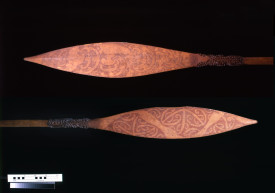 D 1914.66 D1914.67 MAA Cambridge
D 1914.66 D1914.67 MAA Cambridge -
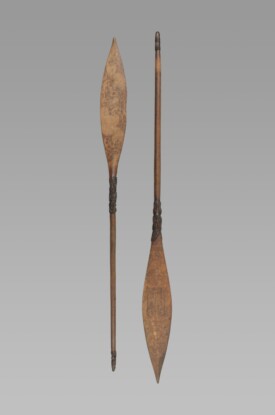 D 1914.66 D1914.67 MAA Cambridge
D 1914.66 D1914.67 MAA Cambridge -
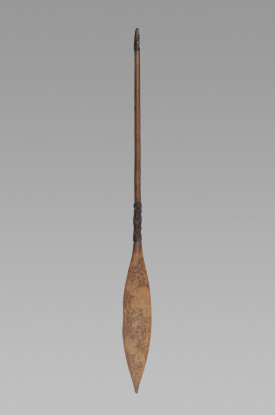 D 1914.67 MAA Cambridge
D 1914.67 MAA Cambridge -
 Oc,NZ.150 British Museum
Oc,NZ.150 British Museum -
 Oc5370 British Museum
Oc5370 British Museum
Tū te Whaihanga Showcase 2
Patu ōnewa weapon Wahaika weapon Patu Parāoa weapon Kotiate weapon
Aurei
Aurei cloak pin Rei-puta, muka harakeke Whalebone-tooth, flax fibre
Tū te Whaihanga Showcase 9
Tātua belt Kahu kurī dog-skin cloak
Tū te Whaihanga Showcase 11
Kōauau flute Paepae hamuti latrine Turuturu weaving peg Waka huia treasure box
Tū te Whaihanga Showcase 1
Pouwhenua weapon Tewhatewha weapon Taiaha weapon
Ambrotype, possibly of Lucy and her daughter Ida Tiffen
The museum is offered many interesting items for the collection over the course of the year. Often they are seemingly ordinary, everyday objects, but what makes each of them special and worthy of collecting is the wonderful stories they can tell us about our region’s history. This wicker basket is certainly one such object. This basket was used by William Hamilton (known as Ham) Hannah (b. 1920, d.1967) to deliver bread for Walter Findlay’s Bakery in the 1930s. Ham would have delivered bread around Gisborne by horse and cart. A few people out there may remember having bread delivered by him, perhaps using this basket! Ham served as a Driver in the Army Service Corps in the Second World War and continued to work as a driver when he returned to Gisborne after the war. In the 1960s, he was the Custodian at Churchill Park. He was married to Sarah (Sadie) and they had four children. We would like to thank Julie Hannah for gifting her father-in-law’s breadbasket to the museum.
Ham and two of his four children, Kevin (left) and Gareth (right), posing in the basket in the garden of the family’s home.
Walter Findlay’s advert, The Gisborne Herald, 20 October 1941
Tū te Whaihanga Showcase 10
Tātua belt Heru Comb Rei-puta whale-tooth necklace Aurei cloak pin Poro-toroa Albatross toggle Kapeu ear pendant
Tū te Whaihanga Showcase 8
Mētara Koroneihana a Hōri III George III Coronation medalet
Tū te Whaihanga Showcase 3
Tīheru/Tata bailer Matau fishhook
Tū te Whaihanga Showcase 13
Patu Parāhe Brass patu
Tū te Whaihanga Showcase 4
Pākē rain cape
Tū te Whaihanga Showcase 6
Kaitaka cloak
The museum’s collections are always growing and on this page we share some of the highlights. Our thanks to the donors for their support.
Donating to the collection
Visit our Donations page for more information.
Research and access
Researchers can view collections that are not on display by making an appointment with the Museum Collection Manager. Staff can also take small group tours through the collection storage facilities by appointment. Please note that staff are not always available immediately and it is advisable to make arrangements as far in advance as possible, particularly if you are only visiting Gisborne for a short period.
Researchers who are unable to visit in person can make their enquiry by email, letter or telephone
